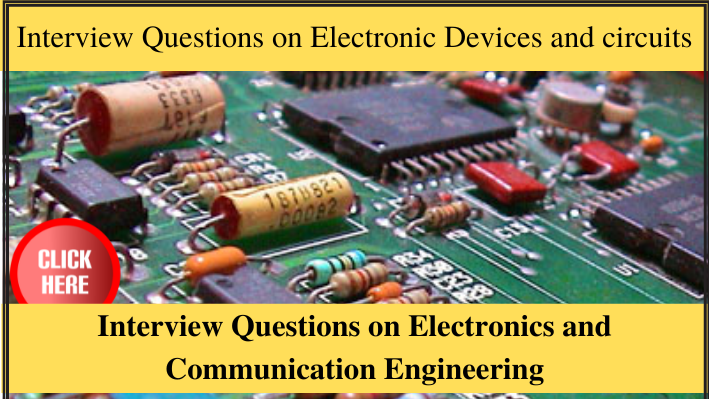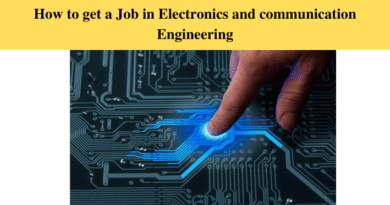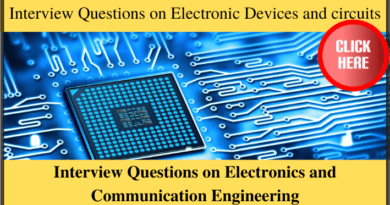Interview Questions on Electronic Devices and circuits
Interview Questions on Electronic Devices and circuits
Hello everyone, In this blog. we will discuss Interview Questions on Electronic Devices and circuits. These Interview questions are asked in many Technical interviews, Please read all questions, and Feel free to ask any doubts or suggestions on it,
Also Read: Python Interview questions
Interview questions on Electronics and Communication Engineering
How to get a job in Electronics and Communication Field
1. What is a diode and how does it work?
A diode is a two-terminal electronic component that conducts current in only one direction. It acts as a one-way valve for electricity. It uses the principle of forward-biased and reverse-biased p-n junctions.
2. What is an operational amplifier (Op-Amp) and its applications?
An operational amplifier is a type of amplifier that is used to perform mathematical operations such as addition, subtraction, integration, and differentiation. Op-Amps are widely used in a variety of applications, including voltage regulation, filtering, and signal amplification.
3. What is the difference between a BJT and a MOSFET?
BJT (Bipolar Junction Transistor) is a type of transistor that uses both electrons and holes as charge carriers. MOSFET (Metal-Oxide-Semiconductor Field-Effect Transistor) is a type of transistor that uses only electrons as charge carriers and is controlled by an electric field. MOSFETs are typically faster and more power-efficient than BJTs, but they are also more sensitive to noise.
4. What is an RC circuit and what is its significance?
An RC circuit is a circuit that consists of a resistor and a capacitor connected in series or parallel. RC circuits are significant because they can be used to filter signals and control the flow of current in a circuit.
5. What is a Zener diode and how does it work?
A Zener diode is a type of diode that is designed to operate in reverse-biased mode. Unlike a normal diode, it allows a current to flow in the reverse direction when the voltage exceeds a certain value, called the “Zener voltage.” This allows it to be used as a voltage regulator.
6. What is a transistor and what is its function?
A transistor is a three-terminal electronic component that can be used to amplify or switch electronic signals. It acts as a switch to control the flow of current in a circuit and as an amplifier to increase the amplitude of a weak signal.
7. What is a 555 timer and what are its applications?
The 555 timer is a versatile integrated circuit that can be used to generate a variety of square wave and timing signals. It can be used in applications such as oscillators, flip-flops, and timers.
8. What is a filter circuit and how does it work?
A filter circuit is a circuit that is used to remove or separate certain frequency components from a mixed signal. Filters can be passive or active, and they work by using resistors, capacitors, and inductors to alter the phase and magnitude of the different frequency components of the signal.
9. What is a voltage regulator and what is its importance?
A voltage regulator is an electronic circuit that is used to maintain a constant voltage level in a circuit, regardless of changes in the input voltage or load conditions. Voltage regulators are important because they ensure that the output voltage remains within a specified range, even if the input voltage or load conditions change, which helps to prevent damage to the circuit or the connected devices.
10. What is a digital circuit and how is it different from an analog circuit?
A digital circuit is a circuit that processes digital signals, which are signals that have only two states, such as 0 and 1. Digital circuits use devices such as gates, flip-flops, and counters to process digital signals. An analog circuit, on the other hand, processes analog signals, which are continuous signals that can take on any value within a specified range. Analog circuits use devices such as amplifiers and filters to process analog signals.

Other 10 Interview Questions on Electronic Devices and circuits
1. What is a microcontroller and what are its applications?
A microcontroller is a compact, integrated circuit that contains a processor, memory, and input/output peripherals. Microcontrollers are widely used in a variety of applications, such as controlling appliances, measuring temperature and humidity, and controlling automotive systems. They are also used in embedded systems, such as those found in cell phones and MP3 players.
2. What is a power electronic circuit and what are its applications?
A power electronic circuit is a type of electronic circuit that is used to control and convert electrical power from one form to another. Power electronic circuits are used in a variety of applications, such as voltage regulation, power conversion, motor control, and renewable energy systems.
3. What is a switching power supply and how does it work?
A switching power supply is a type of power supply that uses a switch to regulate the voltage and current output. The switch rapidly turns on and off to control the flow of current in the circuit, and the output voltage is regulated by adjusting the duty cycle of the switch. Switching power supplies are highly efficient, and compact, and can provide a regulated output over a wide range of input voltages and loads.
4. What is a frequency response of a circuit and why is it important?
The frequency response of a circuit is a measure of the circuit’s ability to respond to signals over a range of frequencies. It is important because it determines the circuit’s performance in different applications and helps to determine the suitability of the circuit for a particular application.
5. What is an active filter and what are its applications?
An active filter is a type of filter that uses active components, such as operational amplifiers, to perform the filtering function. Active filters are used in a variety of applications, such as audio systems, communication systems, and medical equipment, where high performance and precision are required.
6. What is a passive filter and what are its applications?
A passive filter is a type of filter that uses only passive components, such as resistors and capacitors, to perform the filtering function. Passive filters are simple, inexpensive, and widely used in a variety of applications, such as power supplies, audio systems, and telecommunications systems.
7. What is a pulse-width modulation (PWM) and what is its significance?
Pulse-width modulation (PWM) is a technique for controlling the average voltage or power output of a circuit by controlling the duty cycle of a square wave signal. PWM is widely used in a variety of applications, such as motor control, power conversion, and lighting control, because it provides a high-efficiency and versatile method of controlling the flow of power.
8. What is a charge-coupled device (CCD) and what are its applications?
A charge-coupled device (CCD) is a type of light-sensitive integrated circuit that is used to capture images in digital cameras and other imaging systems. CCDs work by converting light into electrical charges, which are then transferred and read out to produce an image. CCDs are widely used in a variety of applications, such as scientific imaging, medical imaging, and industrial inspection.
9. What is a photovoltaic cell and how does it work?
A photovoltaic (PV) cell is a type of device that converts light into electricity. It consists of a p-n junction, which is created by joining two semiconducting materials and works by absorbing photons from light and releasing electrons, which then flow through an external circuit to produce an electrical current.
10. What is a power electronics converter and what are its applications?
A power electronics converter is a type of device that is used to convert electrical power from one form to another, such as AC to DC, DC to AC, or DC to DC. Power electronics converters are widely used in a variety of applications, such as renewable energy systems, electric vehicles, and industrial motor control.
Conclusion: I hope you like this blog, Keep in touch with us for more interesting interview questions. Also, visit our main Website Digital Tech Fact



